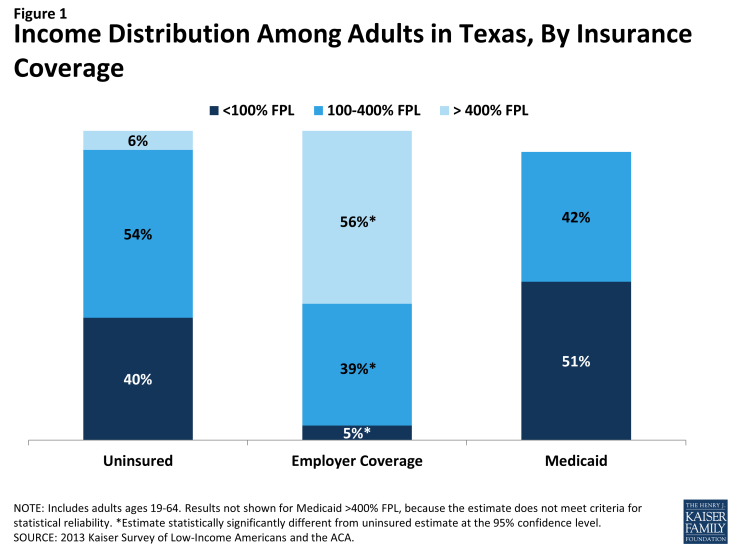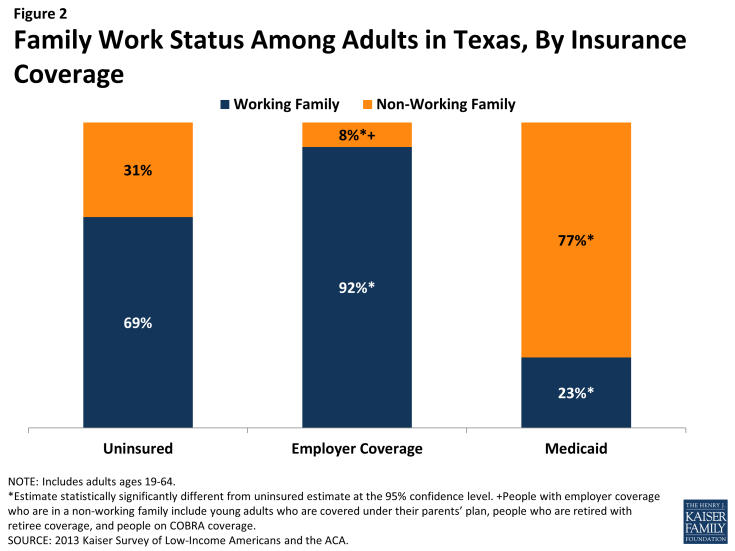The Uninsured Population in Texas: Understanding Coverage Needs and the Potential Impact of the Affordable Care Act
Characteristics of Uninsured Adults in Texas
While the population without health insurance coverage in Texas includes people from a range of backgrounds, most uninsured Texan adults are low-income workers. Uninsured adults in the state are also, on average, younger and more likely to be people of color than those who have insurance. In addition, while most uninsured adults are citizens or legal immigrants, a notable share of uninsured adults in Texas are undocumented immigrants, who remain outside the reach of many provisions of the ACA.
Most uninsured adults are in low-income working families.
Uninsured adults in Texas are more likely than other residents to be low-income. For example, 40% of uninsured adults are poor (that is, living below the poverty level) in contrast to 5% of adults with employer coverage (Figure 1 and Appendix Table A1). People living below the poverty level live on limited resources: In 2014, the poverty level for a family of three is less than $20,000 a year.1 In Texas, most poor uninsured adults are ineligible for coverage expansions under the ACA. Adults with Medicaid are the most likely of any coverage group to be poor, reflecting the fact that adult income eligibility is limited to those with very low incomes.2
About half of uninsured adults in Texas have family incomes between 100 and 400% of poverty (Figure 1), the income range for premium tax credits for Marketplace coverage. Some of these people may be not be able to obtain tax credits due to their immigration status or because they have an offer coverage from an employer. However, most are potentially eligible for financial assistance in purchasing coverage.
Though they are primarily low-income, most uninsured Texans are in a working family. Nearly seven in ten (69%) uninsured Texan adults live in families where they or their spouse are working either full or part-time (Figure 2). These workers may be employed by someone else or may be self-employed. Few adults who meet the limited income levels for Medicaid eligibility in the state are in a working family (23%), as even limited earnings are likely to make adults ineligible. However, not surprisingly, most adults with employer coverage are in a working family, which is the main pathway to their coverage.
The data on the income and work status of uninsured Texas adults indicates that the challenge of extending coverage may be linked more to affordability and access than to lack of jobs. Though most uninsured adults or their spouses work, most still live on very limited means and are unlikely to be able to afford coverage on their own.
Demographic characteristics of uninsured adults could inform outreach efforts.
Uninsured adults in Texas also differ from insured adults with regards to demographic characteristics, often reflecting an association with income or work status. For example, uninsured adults are likely to be younger than insured adults, as younger adults have lower incomes and looser ties to employment than older adults. Nearly seven in ten (69%) uninsured adults in Texas are ages 19-44 compared to 55% of adults with employer coverage and 44% with Medicaid (Appendix Table A1). There also are significant racial and ethnic differences in health coverage among nonelderly adults in the state, primarily reflecting differences in income by race/ethnicity. For example, uninsured adults are more likely to be Hispanic (56%) than adults with employer coverage (24%).
Most (62%) uninsured adults in Texas are U.S. citizens. Of those who are not citizens, however, many are undocumented immigrants. The survey estimates that undocumented immigrants make up 20% of the uninsured adult Texas population.3 Under federal law, undocumented immigrants are not eligible for Medicaid. As a result, even if Texas were to expand the Medicaid program, a sizeable number of Texas residents would remain uninsured. Further, many Texas families include both documented and undocumented immigrants, and these families often see government-run programs through the prism of protecting immigration status information about their family members.
Understanding the demographic characteristics of the remaining uninsured population in Texas can inform efforts to reach, educate, and enroll individuals into health coverage under the ACA and to continue to serve the uninsured in the state. Information on how to navigate the health care system can be tailored to specific age groups or ethnic groups to reach them more effectively. Conveying how the ACA does or does not tie into immigration may be important for outreach and communication with the immigrant community.




